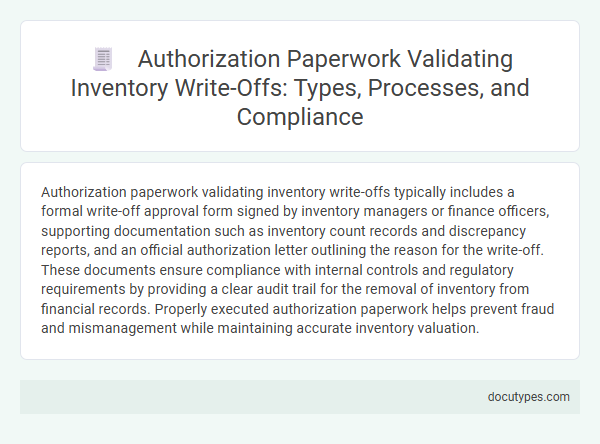Authorization paperwork validating inventory write-offs typically includes a formal write-off approval form signed by inventory managers or finance officers, supporting documentation such as inventory count records and discrepancy reports, and an official authorization letter outlining the reason for the write-off. These documents ensure compliance with internal controls and regulatory requirements by providing a clear audit trail for the removal of inventory from financial records. Properly executed authorization paperwork helps prevent fraud and mismanagement while maintaining accurate inventory valuation.
Introduction to Authorization Paperwork for Inventory Write-Offs
Authorization paperwork for inventory write-offs serves as essential documentation to validate the removal of inventory items from records. This paperwork typically includes detailed forms outlining reasons for the write-off, approval signatures from authorized personnel, and references to company policies. Understanding the requirements for proper authorization ensures your inventory adjustments are compliant and accurately recorded.
Understanding Inventory Write-Offs: Definitions and Importance
Inventory write-offs occur when goods are deemed unsellable due to damage, theft, or obsolescence. Proper documentation is critical to validate these write-offs and maintain accurate financial records.
Authorization paperwork, such as inventory adjustment forms and approval signatures from management, ensures accountability and compliance with company policies. These documents verify that the write-off is legitimate and properly recorded in your accounting system.
Types of Authorization Paperwork for Inventory Write-Offs
Authorization paperwork validating inventory write-offs includes official documents such as inventory write-off forms, adjustment approval requests, and managerial authorization letters. These documents provide a formal record of approval from designated personnel ensuring compliance with company policies and accounting standards. Proper types of authorization paperwork ensure transparency and accountability in inventory management processes.
Key Documents Required for Validating Inventory Write-Offs
| Key Documents | Description | Purpose in Inventory Write-Offs |
|---|---|---|
| Write-Off Request Form | A formal document initiated by responsible personnel to propose the removal of inventory items. | Serves as the initial authorization, detailing reasons and items affected. |
| Inventory Adjustment Report | Report generated from the inventory management system reflecting the changes after write-off approval. | Validates the quantity and value adjustments in inventory records. |
| Authorization Approval Signatures | Sign-offs from management, finance, or relevant departments approving the write-off. | Confirms official consent and accountability for the write-off decisions. |
| Supporting Documentation | Includes purchase invoices, damage reports, or obsolescence evidence related to the inventory items. | Provides justification and evidence backing the necessity for the write-off. |
| Audit Trail Records | Digital or physical logs capturing the write-off process steps and approvals. | Ensures transparency and compliance during internal or external audits. |
Standard Processes for Authorizing Inventory Write-Offs
Authorization paperwork for inventory write-offs is essential for maintaining accurate financial records and preventing unauthorized loss of assets. Standard processes ensure that write-offs are properly reviewed and approved before inventory adjustments are recorded.
- Write-Off Request Form - This document initiates the process by detailing the items to be written off and the reasons for disposal.
- Manager Approval - A designated manager validates the legitimacy of the write-off request and authorizes the adjustment.
- Inventory Adjustment Report - This report records the approved write-off in the inventory system for accurate accounting and audit trails.
Roles and Responsibilities in the Authorization Workflow
Authorization paperwork validating inventory write-offs typically includes approved inventory adjustment forms and supervisor or manager sign-offs. These documents ensure that write-offs are properly recorded and traceable within the inventory management system.
Roles in the authorization workflow include inventory clerks who initiate write-off requests by documenting discrepancies. Supervisors review and approve these requests to confirm accuracy and legitimacy. Finance personnel often perform final audits to validate the financial impact before updating accounting records, ensuring accountability at each step of the process.
Best Practices for Documentation and Record-Keeping
What authorization paperwork validates inventory write-offs? Proper documentation includes signed write-off approval forms and inventory adjustment logs that detail the reasons and quantities involved. These records serve as essential proof for audits and help maintain accurate financial reporting.
How can you ensure best practices for documentation and record-keeping? Maintain thorough, organized paperwork with clear signatures, dates, and explanations for each write-off to support accountability. Regularly review and securely store these documents to comply with company policies and regulatory requirements.
Compliance Requirements for Inventory Write-Off Authorization
Authorization paperwork for inventory write-offs must comply with established internal controls and regulatory standards to ensure accurate financial reporting. Valid documentation supports audit trails and safeguards against unauthorized asset removal.
- Write-Off Approval Form - This document requires signatures from designated management personnel to validate the legitimacy of the inventory write-off.
- Inventory Adjustment Report - Provides detailed account of the items being written off, including reasons and quantities, ensuring transparency in the process.
- Compliance Checklist - Confirms that the write-off adheres to company policies and external regulations, maintaining your organization's accountability.
Common Challenges in Validating Inventory Write-Offs
Authorization paperwork validating inventory write-offs is essential for maintaining accurate financial records and preventing fraud. Proper documentation ensures inventory discrepancies are justified and approved by the appropriate personnel.
- Incomplete Documentation - Missing or partial paperwork can lead to unauthorized or unverified write-offs, causing audit issues.
- Insufficient Approval - Write-offs lacking signatures from designated authorities increase the risk of improper inventory adjustments.
- Poor Record Keeping - Disorganized or inconsistent records hinder validation efforts and complicate inventory reconciliation.
Your company must establish clear authorization protocols to overcome these challenges and safeguard inventory accuracy.
What Authorization Paperwork Validates Inventory Write-Offs? Infographic

